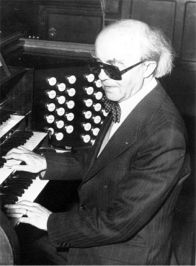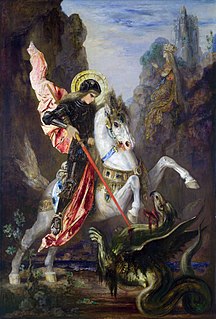External links
- Free scores by Richard Hygons in the Choral Public Domain Library (ChoralWiki)
Richard Hygons (also Higons, Huchons, Hugo; c. 1435 – c. 1509) was an English composer of the early Renaissance. While only two compositions of this late 15th-century composer have survived, one of them, a five-voice setting of the Salve Regina Marian antiphon, has attracted interest from musicologists because of its close relationship to music being written at the same time on the continent, as well as its high level of workmanship.
Hygons seems to have spent his entire career at Wells Cathedral; at any rate, no records survive indicating his activities elsewhere. He is first mentioned in 1458 as a vicar-choral, and in 1460 he was ordained as an acolyte. Between 1461 and 1462 he was one of the five organists that the cathedral employed. A document dated 7 December 1479 gives more detail than any other about his duties: he was given a house to use, rent-free, near to the cathedral; he was given an annual salary of a little over 96 shillings; he was to teach all aspects of music to the choristers, and was expected to teach organ to anyone who had the talent. His required presence at certain masses, Vespers, and Matins was also given in detail.
In 1487 he received a substantial raise in annual salary, and became the principal organist of the cathedral. By 1507 his health was in decline, and he appointed a deputy (Richard Bramston) to help him carry out some of his duties. He was still alive in May 1508, when he hired another assistant, and he died at Wells, probably in 1509.
Only two compositions of Hygons are known to survive: a two-voice setting of the Gaude virgo mater Christi, which appears on a single surviving leaf of a choirbook from Wells Cathedral (the enormous majority of music from the 15th century and early 16th century was destroyed in the Dissolution of the Monasteries by Henry VIII), and the famous Salve Regina from the Eton Choirbook.
The Salve Regina is unique among English music of the period in that its cantus firmus, drawn from the melisma on the word "caput" in the Sarum antiphon Venit ad Petrum, is the same as that from three earlier Caput masses by composers from elsewhere: Jacob Obrecht, Johannes Ockeghem, and an anonymous composer once thought to be Guillaume Dufay. Recent research has suggested that this third mass was actually by an unknown Englishman working in the early 15th century, and is the original for the later three works. The Salve Regina, being based on a votive antiphon for Maundy Thursday, was probably intended for use on that day.
The difficulty, complexity, and craftsmanship shown in Hygon's Salve Regina has suggested that the musical standards at Wells Cathedral at the end of the 15th century were high, and matched those of musical centres across the Channel.

Johannes Ockeghem was the most famous composer of the Franco-Flemish School in the last half of the 15th century, and is often considered the most influential composer between Guillaume Dufay and Josquin des Prez. In addition to being a renowned composer, he was also an honored singer, choirmaster, and teacher.

Guillaume Du Fay was a Franco-Flemish composer of the early Renaissance. A central figure in the Burgundian School, he was regarded by his contemporaries as one of the leading composers in Europe in the mid-15th century. His uniquely contrapuntal and complex motet "Nuper rosarum flores" demonstrates the influential exchange of musical ideas among artists around the world during the early Renaissance period.
William Cornysh the Younger was an English composer, dramatist, actor, and poet.

Jean Langlais was a French composer of modern classical music, organist, and improviser. He described himself as "Breton, de foi Catholique". His works include masses and organ music, some based on Gregorian themes, enhanced by polymodal harmonies, as well as music for other forces.
Giovanni Francesco Anerio was an Italian composer of the Roman School, of the very late Renaissance and early Baroque eras. He was the younger brother of Felice Anerio. Giovanni's principal importance in music history was his contribution to the early development of the oratorio; he represented the progressive trend within the otherwise conservative Roman School, though he also shared some of the stylistic tendencies of his brother, who was much indebted to Palestrina.
Hugh Aston was an English composer of the early Tudor period. While little of his music survives, he is notable for his innovative keyboard and church music writing. He was also politically active, a mayor, Member of Parliament, and Alderman.
Pierre Moulu was a Franco-Flemish composer of the Renaissance who was active in France, probably in Paris.
Hernando Franco was a Spanish composer of the Renaissance, who was mainly active in Guatemala and Mexico.
Leonel Power was an English composer of the late Medieval and early Renaissance eras. Along with John Dunstaple, he was one of the major figures in English music in the early 15th century.

The Eton Choirbook is a richly illuminated manuscript collection of English sacred music composed during the late 15th century. It was one of very few collections of Latin liturgical music to survive the Reformation, and hence is an important source. It originally contained music by 24 different composers; however, many of the pieces are damaged or incomplete. It is one of three large choirbooks surviving from early-Tudor England.
Robert Carver CRSA was a Scottish Canon regular and composer of Christian sacred music during the Renaissance.
Jacobus Vaet was a Flemish composer of the Renaissance. He was a representative of the generation between Josquin and Palestrina, writing smooth polyphony with pervasive imitation, and he was a friend both of Clemens non Papa and Lassus.
Joan Pau Pujol was a Catalan and Spanish composer and organist of the late Renaissance and early Baroque. While best known for his sacred music, he also wrote popular secular music.
Robert Fayrfax was an English Renaissance composer, considered the most prominent and influential of the reigns of Kings Henry VII and Henry VIII of England.

The Missa Caput was a musical setting of the Roman Catholic mass, dating from the 1440s, by an anonymous English composer. It circulated widely on the European continent in the mid-15th century and was one of the best-loved musical works of the early Renaissance in Europe, judging by the number of copies that have survived, and the number of imitations it inspired. It was influential both for its use of a tenor cantus firmus which unified all the movements and for being the first extended composition with a freely composed bass line, a feature with extraordinary ramifications in music history.
John Browne was an English composer of the Tudor period. Despite the high level of skill displayed in Browne's compositions, few of his works survive; Browne's extant music is found in the Eton Choirbook, in which he is the best-represented contributor, and the Fayrfax Manuscript. His choral music is distinguished by innovative scoring, false relations, and unusually long melodic lines, and has been called by early music scholar Peter Phillips "subtle, almost mystical" and "extreme in ways which apparently have no parallel, either in England or abroad."

Juan de Anchieta was a leading Spanish Basque composer of the Renaissance, at the Royal Court Chaplaincy in Granada of Queen Isabel I of Castile.
Nicholas Ludford was an English composer of the Tudor period. He is known for his festal masses, which are preserved in two early-16th-century choirbooks, the Caius Choirbook at Caius College, Cambridge, and the Lambeth Choirbook at Lambeth Palace, London. His surviving antiphons, all incomplete, are copied in the Peterhouse Partbooks. Ludford is well-known as being the composer of the only surviving cycle of Lady Masses, small-scale settings of the Ordinary and Propers in three parts to be sung in the smaller chapels of religious institutions on each day of the week. Ludford's composing career, which appears to have ended in 1535, is seen as bridging the gap between the music of Fayrfax and that of John Taverner (1495–1545). Music scholar David Skinner has called Ludford "one of the last unsung geniuses of Tudor polyphony". In his Oxford History of English Music, John Caldwell observes of Ludford's six-part Mass and Magnificat Benedicta that it "is more a matter of astonishment that such mastery should be displayed by a composer of whom virtually nothing was known until modern times".

Roman Catholic Marian music shares a trait with some other forms of Christian music in adding another emotional dimension to the process of veneration and in being used in various Marian ceremonies and feasts. Marian music is now an inherent element in many aspects of the veneration of the Blessed Virgin Mary in Roman Catholic Mariology.
Juan de Lienas was a composer active in Latin America during the early to mid-17th century. He also served as a chapel master and conductor in the Catholic Church. Much of his life is still a mystery, but what is known comes from accounts in the only two manuscripts that include his compositions: El Codice del Convento del Carmen and the Newberry Choirbooks. Some of these comments are unflattering to the composer, insulting his appearance and personality. He is identified as a cacique, an Indian, and a married man, all of which may have kept him from higher standing within the church. One scholar indicates that he may have been born in Spain. Most scholars place him in Mexico in the employ of the convent connected to the cathedral of Mexico City, but one asserts that he also worked in Havana. His music is indicative of the early Renaissance, following the Polyphonic styles of composers such as Francisco Guerrero and Cristóbal de Morales. He is often associated with Juan Hernandez, Fernando Franco, and Francisco López. The latter two also had compositions in the Carmen Codex. His known compositions include: two masses, eleven motets, three magnificats, and two sets of lamentations. The two manuscripts which include his music may have at one point been connected. Both include his Salve Regina for 4 voices, Lamentation for 4 voices, and Magnificat for 5 voices. His compositions were first brought to the states by means of the Newbery Choirbooks, which are still performed today.